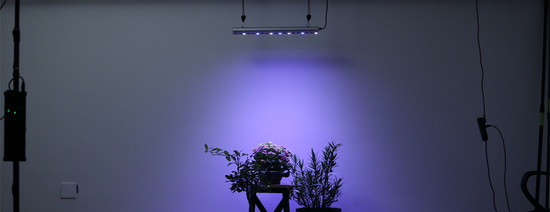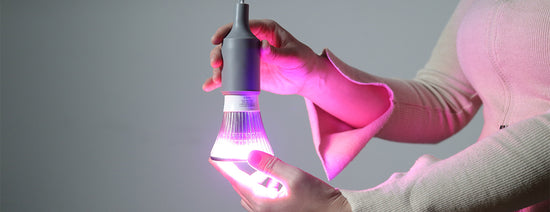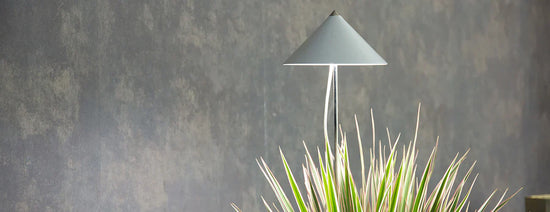Plant preservation indoors
Light is no longer a limiting factor for establishing your dream plants indoors. You no longer have to make any compromises when it comes to the color of the light. With the right LED plant lamps, you get coordinated light spectra with a warm white light color that adapt perfectly to your living environment.
The coordinated light spectrum in the area of year-round plant maintenance consists of white and red wavelength ranges. White light is a full spectrum 400-700nm that stimulates the growth and maintenance of the root system. The wide light spectrum also stimulates the formation of new leaves and causes the existing leaves to become stronger and juicier in color. Together with the light spectrum of red wavelengths (640-660nm), the growth of flowers is promoted and the preservation of flowers or the flowering phase is significantly extended.
The light from the lamps used is usually warm white (4000 Kelvin), but plant lamps that shine in cool white (5000 Kelvin) are also available. A special light spectrum was developed for the plant lamps from Venso EcoSolutions, which offers the plants an optimal spectrum for promotion and maintenance and at the same time is suitable for uncompromising use indoors. With the right LED plant light, you can provide your chosen potted plants, hydroponics, palm trees and even your green walls with plenty of light, which further stimulates plant growth even with less light.
Plants have very different light requirements. They can be roughly divided into three categories: light plants, semi-shade plants and shade plants. It is important that you can adapt the light requirements to the conditions available to you as best as possible in order to optimize the supply of light for vital growth.
As a rule of thumb, you can assume that only about half of the available light gets through the window pane. This condition can be further aggravated if the window panes are dirty. In addition, windows also filter out the red wavelengths to a certain extent, depending on the thickness and glazing of the window. These red wavelengths are important for plants to flower. Also, watch your plants how they are doing in the window location, because a window pane can act like a magnifying glass, so your plants could get burned in strong sunlight. Also make sure that your plants do not dry out and die of thirst due to the strong sunlight on the window and the dry heating air. Especially during the winter time, plants are more susceptible to pathogens and diseases due to the combination of little light, lots of heat and a disturbed water and nutrient turnover.
If you have your plants near the window at ground level, there will only be about a fifth of the available light at that point. As soon as the plants are about 1-2 meters away, the plants can only be supplied with about 10-15% of the light they need, even if this space appears bright and flooded with light to humans. This means that plants indoors very quickly have to struggle with an undersupply of light. As soon as you notice deficiencies in your plants, you should think about buying an LED plant light to supplement the light.
Even windowless rooms such as bathrooms, hallways or stairwells can be illuminated with LED plant lights, making them an ideal location for indoor plants. Especially in the bathroom, the high humidity is very suitable for a wide variety of plant species.
What is the difference between an LED plant light and a normal lamp?
In order to stimulate plants to photosynthesize with the help of artificial lighting, you need special plant lighting (the "normal" lamps that are otherwise available are not suitable for this). The biggest difference lies in the color spectrum , i.e. the composition of the light. On the one hand there is plant lighting, which shows a full spectrum, but there are also plant lighting with special spectra.
Natural daylight contains all wavelengths, i.e. a full spectrum. Plants primarily need the blue and red parts. Growth lamps sometimes have primarily red and blue components , which explains the light that appears slightly violet. However, it is not only light from these ranges that affects photobiological growth, but also light from other wavelength ranges. As in most areas of artificial lighting, many plant lamps are now operated with LEDs. As a result, the electricity costs are low even with naturally longer lighting times.
What should be considered with a plant light?
Plant lamps are so-called special lamps, in this case for use to ensure healthier growth of indoor plants, for example, when there is insufficient daylight. The light of these special lights is limited suitable for illuminating living spaces. The exact area of application should also be considered in advance. Because if plant lamps are to be used in damp rooms, for example, they need a higher IP protection class , such as IP65, in order to be adequately protected against water.
How long should an LED plant light shine?
First we want to clear up the misconception that the Calvin cycle (also known as the dark reaction) only takes place in the dark phase. This takes place directly after the light reaction during the day and is referred to as the dark reaction because it can take place without the direct involvement of light. However, it absolutely needs the substances produced in the light reaction. This means for photosynthesis, at least for C3 and C4 plants, that no dark phase is necessary. In comparison, CAM plants fix carbon dioxide at night and therefore keep their stromata (leaf openings) closed during the day to avoid losing water to the environment through evaporation. As a result, these plants are particularly well adapted to dry areas. Nevertheless, the Calvin cycle mentioned above also runs during the day in this type of plant, directly coupled to the light reaction.
The cycle of plant growth of many plants is controlled by light. This phenomenon is also called photoperiodism. For example, by shortening the lighting time for short-day plants, flowering can be achieved, for so-called long-day plants it can be lengthened or additional lighting is required. There are also "day-neutral" plants, this species flowers regardless of the photoperiod. Another distinction is made with plants that require at least two different lighting times to induce flowering, so that the plant can determine whether the days are getting shorter or longer. The flowering of the plant itself makes clear the many processes triggered in a plant by the duration of the lighting. With short-day plants, lighting is possible 24 hours a day, although most growers see no advantages in this and prefer to light the plants for only 18 hours a day to save energy. A long-day plant, on the other hand, needs a dark phase of a certain length in order not to immediately switch to the flowering phase. Finally, it can be said that how much light a plant needs and how long the dark phase should be depends heavily on the plant species.





